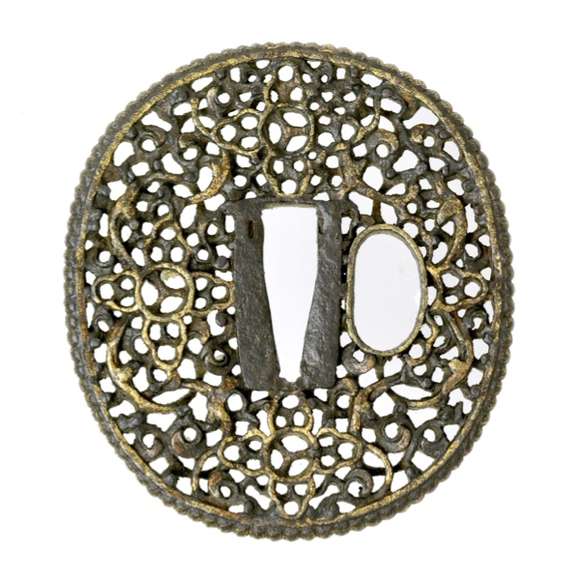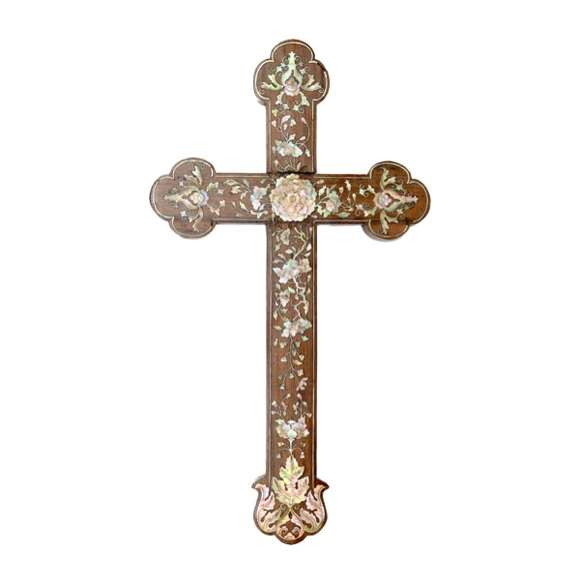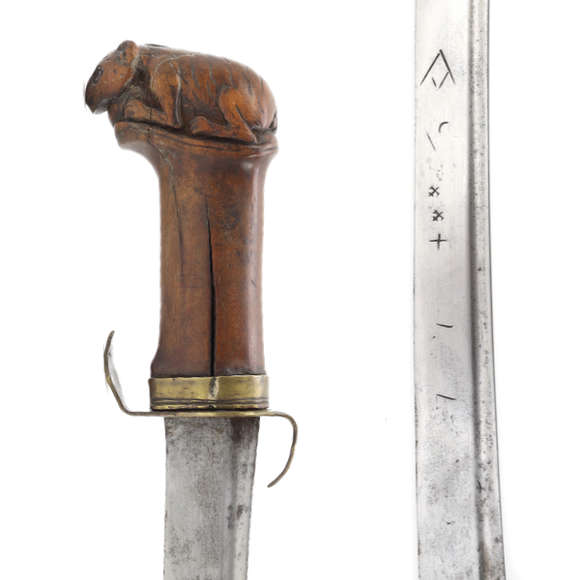Language: Unknown
Source: Period writings
Description
Sawasa is a term used to describe a distinctive style of metalwork produced in Asia during the 17th and 18th centuries. The base material was a copper-gold alloy, much like the Japanese shakudō (赤銅). The final objects were finished in black and gold, the black was often achieved through controlled patination but sometimes through lacquering, and the gold was usually applied by means of mercury gilding, but sometimes inlay is seen as well.1
Sawasa articles usually appear in the form of containers like tobacco boxes, cups and saucers, ewers, and other items for which the material is suited. Among the more rare sawasa items are a set of coat buttons and walking canes knobs. In the realm of arms and armor, sawasa was mainly used for lavish hilts for smallswords and hunting hangers. It was also used or high end fittings for swords, polearms and muskets in 17th-century Vietnam.
Notes to description
1. Rijksmuseum; Sawasa: Japanese Export Art in Black and Gold 1650-1800. Zwolle, Waanders Publishers, 1998.
Production centers
The production of sawasa items is primarily associated with Nagasaki, but various records suggest there was also production in Canton (Guangzhou) and Tonkin (Hanoi), and possibly even Batavia. Perhaps not coincidentally, all these places had a substantial population of Chinese, among which many craftsmen, who may have been the main producers of the style.
The clientele was mainly the Dutch colonial expat community, who commissioned these items for their own use and, to some extent, for trade with Europe.1
Notes to description
1. Rijksmuseum; Sawasa: Japanese Export Art in Black and Gold 1650-1800. Zwolle, Waanders Publishers, 1998.
Related materials
The base material for sawasa is often likened to Japanese shakudō, a copper-gold alloy that was patinated a "raven black" by means of pickling and might indeed be quite similar if not identical to it, differing mostly in style.
In China, a similar black-patinated alloy called wu tong was produced. It was mainly decorated by means of inlays of brass or gold. In Tibet, a similar alloy was called dzne-ksim.1
It was also seen on Vietnamese sword and pole arm mounts of the 17th century, but no name for the work is known to me.2
In Burma, dark blue patinated copper alloy mounts are seen on some Bamar dha, particularly those from Mindan.3
And finally, there was a production of sword mounts, pipes, and other items in the style in Korea from at least the 17th century.
See
1. Paul Craddock, Maickel van Bellegem, Philip Fletcher, Richard Blurton and Susan La Niece; The Black Bronzes of Asia. Published in J. Mei and Th. Rehren (eds), Metallurgy and Civilisation: Eurasia and Beyondrchetype, London 2009.
2. This is mainly apparent from a small number of antique objects, including a sword and spear in my collection and a fine matchlock musket sold by Peter Finer of London. Others are scattered over European and Russian museum collections, often mislabeled as Japanese.
3. Maickel van Bellegem, Philip Fletcher, Paul Craddock, Susan La Niece and Richard Blurton; The Black Bronzes of Burma. Published in The British Museum, Technical Research Bulletin, 2007.
4. Paul Craddock, Maickel van Bellegem, Philip Fletcher, Richard Blurton and Susan La Niece; The Black Bronzes of Asia. Published in J. Mei and Th. Rehren (eds), Metallurgy and Civilisation: Eurasia and Beyondrchetype, London 2009.
In period sources
Curiosities in a Temple at Fakone
Amidst the above-said chappels stands the small temple Fackone Gongin, very famous for several remarkable curiosities, which are kept and shewn there. Such are: four sabres or scimeters great and small, with the handles made of Sawaas, and inlaid with gold, one of the four being still rusty with blood, so as to stick fast to the sheaths, they belong’d formerly to certain ancient heroes, whose names and heroick achievements, said to be done with the very same swords, I purposely omit: two fine branches of coral: two horns of horses, each two Suns, and six Bus long, and equally thick: two vast large cockleshells; two stones, one taken out of a cow, the other out of a stag: a suit of cloth made of Ama, such as the Angels wear in Heaven and can fly with: the comb of the first secular monarch Joritomo, with his coat of arms upon it: the bell of Kobodais, founder of the N. sect, which he rung, when in prayers, and a letter wrote by Takimine’s own hand. Every one of these curiosities, which they call Gongins, or jewels, hath its particular name, as being reckon’d exceedingly scarce and valuable things.1
-Engelbert Kaempfer, 1691.
A.D. 1690 - 1692 Nagasaki
"Except articles made of gold, silver, and Sawaas, -a mixture of gold, silver, and copper, - for the foreign trade, manufactures at Nagasaki are not so good as in other parts of the empire; and yet everything is sold dearer, chiefly to foreigners.
The inhabitants are mostly merchants, shop-keepers, tradesmen, handicraftsmen, artificers, brewers, besides the numerous retinue of the governors, and the people employed in the Dutch and Chinese trade, by which, in fact, the town is mainly supported." 2
-Engelbert Kaempfer, 1691.
Notes to period sources
1. Engelbert Kaempfer; The history of Japan, together with a description of the kingdom of Siam, 1690-92. Glasgow, J. MacLehose and sons, 1906. Page 61.
2. Ibid.






